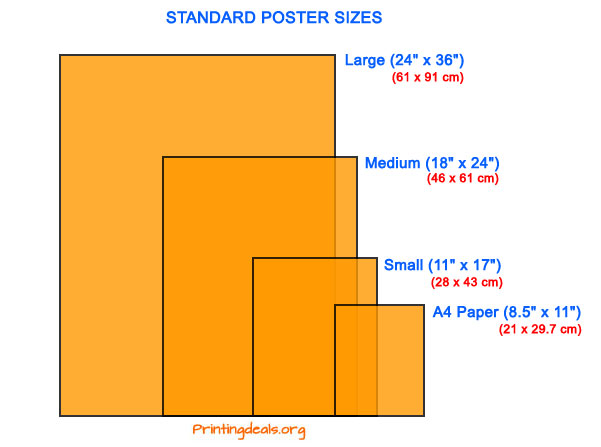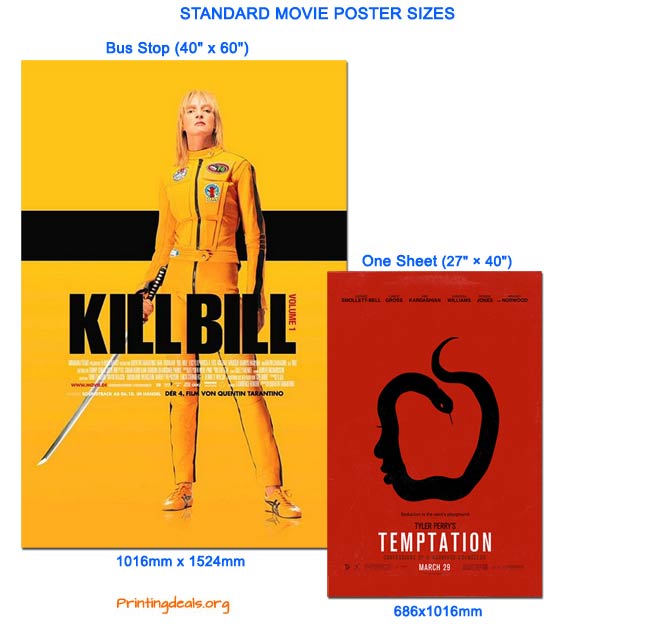While there is no official standard size for posters, over the decades many printing and advertising companies have been using the same consistent sizes for poster printing.
This resource discusses the dimensions and rules that are commonly used for printing posters worldwide. Using the dimensions in this guide will assure your poster printing project will turn out to be a success - no matter what printing company you choose.

Also called Ledger, Tabloid or ANSI B size. This is the smallest standard poster size, they are mostly used for flyers, street lights, bulletin boards, and generally putting up on businesses without taking up too much room and offending. These also work great with a minimalist approach to text. Big letters big message. Size in Millimetres is 279 x 432mm.
Also called Architectural C size - A little more information can be displayed on this standard poster size. I would still recommend some minimalism and little text. These posters are mainly seen as small adverts on university residence floors, doctor's offices, construction walkways and bulletin boards. Size in Millimetres is 457 × 610mm.
Also called Architectural D Size - This is the most common standard size for posters. These posters are used for most applications including outside of events, trade shows, and malls. Also widely used for small movie posters delivered to fans and posters for decoration like in University residences and outside a pub or club. With these types of posters you will be grabbing attention with a large message and you can include further details in small writing so after the message is received people can choose whether to come closer and learn more. Size in Millimetres is 609.6 mm x 914.4 mm.
Note: If you are designing a poster you cannot go wrong by using the dimensions that we described above, they are used by printing companies worldwide. Don't be afraid to work with different dimensions though: Posters are printed on rolls of paper (not on sheets) and can therefore be cut in any other dimension. If you want create a poster larger than 24 x36 Inch be sure to contact your printer first, and confirm that he is able to print your desired size.There are 2 different dimensions for movie posters that the film industry has standardized. Both are typically in portrait format:
The "One-Sheet" size is used in the official advertising for films.
Both are typically printed on paper stock and usually rolled for aesthetic reasons.
Be aware that the mentioned dimensions for film posters are approximate, and do not have to be exactly in the sizes mentioned above.

Note: Film posters sold in retailing are in poster size, which is 24 x 36 inches.
Common landscape (horizontal oriented) format movie Posters also called HALF-SHEET measure 22" x 28", and are generally printed on thicker stock paper.
For further in-depth information about movie poster sizes visit Cinemasterpieces and Wikipedia.
Choosing the right paper to print your posters is essential. The first thing to note is: Always use Acid free paper for poster printing. You do not want your printed poster to turn yellow after a while, therefore the papers you use for printing should be acid free.
The best stock to use for your poster depends on many factors, that are not defined by hard rules.
These factors include:
As a rule you want to make sure to use stock that is heavier (thicker) then default printer papers.
Not only does this add durability to your poster, it will age much better then standard paper, and your poster is much easier to flatten.
We recommend to choose paper weight of at least 60lbs (90 g/m2) or above for your poster project. This really is the minimum weight you should choose for (bulk) production.
If your budget allows it, preferably choose heavier papers like (80 lbs - 120 g/m2 or 90 lbs - 163 g/m2). This will give your poster a more luxurious feel and will add longevity to your poster.
When creating your own poster make sure to create your document in CMYK mode in 300DPI and set a healthy amount of bleed around the edges so that essential pieces of the poster are not cut off after the printing. For more information read our printing guide to avoid common printing mistakes.
» Free downloadable high-res Vintage posters for printing.
» Reviews of the best poster printing services.
Every company has errors, but so far I have gotten everything I have ordered on time or before, even with their 2 day shipping.
Everything always comes out great and I will be returning for all my needs. The products are high quality and the person I was working with was very helpful
 Rating: 5 / 5
Rating: 5 / 5
I ordered a T-shirt for my son from Cafepress, but im dissapointed by the quality. The T-shirt was supposed to be 100% cotton as stated on their website, but it's not: it contains 5% spandex which is really hot and uncomfortable. This was a dissapointing experience with Cafepress.
 Rating: 2 / 5
Rating: 2 / 5
I love Snapfish and always have. I needed three canvas photos delivered in time for my parents anniversary, and realized I wouldn't get them in time.
Instead of paying for expedited shipping, I gave them a call, they were kind enough to put a rush on finishing order, and I got them one day early (4 days earlier than they were scheduled) at no extra charge!
They're a wonderful company. And you can always find discount coupons online!
 Rating: 5 / 5
Rating: 5 / 5
When you first get a glimpse of their website you don't expect very much. Let's face it, their website looks pretty outdated!
However, and this is a big however, the printing quality speaks for itself. I usually use them for business cards and flyers but I also had to get some calendars and they look pretty good, considering I used my own photos and they were not very good looking.
One huge downside is the fact they don't offer a lot of customization features which is a shame, considering they deliver high quality printing at super affordable prices. Give them a try, you won't be disappointed.
 Rating: 4 / 5
Rating: 4 / 5
Im a graphic designer and tried all web2print companies around. Printingforless always delivers, knowledgeable people and good support.
 Rating: 5 / 5
Rating: 5 / 5
